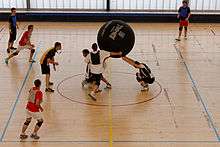Kin-Ball
Kin-Ball, is a team sport created in Quebec, Canada in 1986 by Mario Demers, a physical education professor, in which the main distinctive characteristics are the large size of the ball (1.2m (48 inches) in diameter)[lower-roman 1][1] and that the matches are played among three teams at the same time instead of traditional one-vs-one like the most of the team games. The International Kin-Ball Federation counts 3.8 million participants, primarily from Canada, the U.S., Japan, Belgium, France, Switzerland, Spain, Germany, Denmark, the Czech Republic, and Malaysia, China. The newest country is the UK. Kin-Ball UK formed in 2018 .

Game
Kin-Ball Diameter: 1.2m (48 inches)[1]
Weigh: 1 kg
Court Size: 20×20 meters (66 feet × 66 feet) (Court lines are included in measurement).
Three teams play per game. Each team has 4 players.
The official Kin-Ball team colours are: Black, Grey and Blue. (Sometimes pink is used instead of blue).
The team in possession of the ball is the Attacking Team. To make a play, the Attacking Team will designate a Defending Team, by calling out their colour. The designation has to start with the declaration "Omnikin!" followed by the colour of another team. After the designation, the ball has to be hit with a body part above the hips, while all other members of the Attacking Team touch the ball, in some way. If the Defending Team is able to control the Kin-Ball successfully, it becomes the Attacking Team.
A Kin-Ball Game is usually played until one team has won three periods. Each period takes about 10 minutes to play. When the first team reaches 11 points in a period, the team with the fewest points has to leave the court and the remaining two teams play until one team reaches 13 points.
A player can commit a series of fouls during the match:
- Not being able to catch the ball before it touches the ground.
- Hitting the ball out of bounds or stepping out of bounds while touching the ball.
- Walking with the ball after the third player touches the ball during a play.
- Hitting the ball with a downward trajectory.
- Hitting the ball less than 1.8 meters.
- Not all players of a team being in contact with the ball.
- Making a mistake during the colour announcement (wrong colour, more than one player talking, etc.).
- Having more than 1 player within 1.8 meters during the hit (close defense).
- Intentionally interfering with a defending player.
Whenever a team commits a foul, the other two teams receive 1 point each. This ensures that teams of a lower skill level are kept in play. So long as they do not commit too many fouls of their own in a row.
International competitions
Men
| Year | City | Gold Medal | Silver Medal | Bronze Medal |
|---|---|---|---|---|
| 2001 | Québec | Canada | Japan | Belgium |
| 2002 | Québec | Canada | Japan | France |
| 2005 | Ans | Canada | Japan | France |
| 2007 | Bilbao | Canada | Japan | France |
| 2009 | Trois-Rivières | Canada | Belgium | Japan |
| 2011 | Nantes | Canada | Japan | France |
| 2013 | Pepinster | Canada | Japan | Belgium |
| 2015 | Torrejón de Ardoz | Japan | France | Czechia |
| 2017 | Tokyo | Canada | Japan | Czechia |
| 2019 | France | CANADA | FRANCE | JAPAN |
Women
| Year | City | Gold Medal | Silver Medal | Bronze Medal |
|---|---|---|---|---|
| 2001 | Québec | Canada | Japan | Belgium |
| 2002 | Québec | Canada | Japan | France |
| 2005 | Ans | Canada | Japan | France |
| 2007 | Bilbao | Canada | Japan | France |
| 2009 | Trois-Rivières | Canada | France | Japan |
| 2011 | Nantes | Canada | Japan | Switzerland |
| 2013 | Pepinster | Canada | Japan | Belgium |
| 2015 | Torrejón de Ardoz | Canada | Japan | France |
| 2017 | Tokyo | Canada | Japan | France |
| 2019 | France | CANADA | CZECHIA | JAPAN |
References
- Unit conversions, and any rounding variations, are as given in the official rulebok.[1]
- "Official Kin-Ball sport Rulebook". International Kin-Ball Sport Federation. 2018.
External links
| Wikimedia Commons has media related to Kin-Ball. |
- International Kin-Ball Federation
- USA KIN-BALL Sport Web Site
- Al Mayrit (Spanish Kin-Ball Team)
- Inclusive Kinball Cup Hong Kong